What is GFP?

Jellyfish Aequorea Victoria, which exhibits a green fluorescence when exposed to light. Source Microbiologics Blog, https://blog.microbiologics.com/green-fluorescent-proteins-shining-new-light-on-food-qc/
Green fluorescent protein (GFP) is a naturally occurring protein found in jellyfish Aequorea Victoria, which exhibits a green fluorescence when exposed to light. This fluorescent protein has transformed biomedical research because cellular biological processes can now be observed in real time. This protein is located in the jellyfish’s umbrella where it interacts with another protein called aequorin. This specific interaction between GFP and aequorin emits blue light when calcium ions are added. Furthermore, this chemical reaction supplies the energy to produce the green fluorescence. GFP consists of 238 amino acids however, the 65thto 67thamino acids form the core structure responsible for emitting the green fluorescence when exposed to light.
This video describes the main components and uses of GFP in biomedical research. Source Alex Dainis, Science Vlogger and Genetics Grad Student.
Why is GFP important?
GFP itself is non-toxic, stable and spontaneously conforms into its functional shape without the need for outside chemicals or enzymes. Also, GFP doesn’t interfere with any of the biological processes within an organism. Therefore, GFP is being used as a visual marker in biomedical research. After, GFP is injected into a cell the green fluorescence glow is observed using a fluorescence microscope. This fluorescence microscope is able to photograph the cellular biological processes without interfering.
For example, in recombinant technology, the GFP gene is combined with a gene of interest, which produces the protein of interest. Then this complex is injected into a cell and if the cell produces the green fluorescent glow it suggests the cell is expressing the gene of interest. Scientists added this harmless fluorescent gene into insulin producing cells in the pancreas of mice. The researchers were able to observe the biological process and reform existing diabetes treatments.
How is GFP relevant to us?
Companies such as Yorktown technologies were the first to start selling fluorescent pet zebrafish called GloFish. Also, the Animal Reproductive Institute of Uruguay produced a glowing green sheep using the GFP gene that was injected into the sheep embryo. Furthermore, a research team in Seoul National University injected beagle dog embryos with a similar fluorescent protein obtained from a sea anemone. As a result four puppies would emit a red fluorescent glow under ultraviolet light. This GFP gene has been injected into other animals too such as cows, pigs, bunnies, monkeys, cats, and rats.
This video describes how GFP can cause animals to be bioluminescent . Source Seeker.
Therefore, GFP has not only transformed biomedical research in the terms of being able to observe how cancer spreads, HIV infections proceed, fetuses grow during development and other various biological processes occur but also, allowed scientists to create glow in the dark pets.
Now, who wouldn’t want a glowing green pet!
Sabrina Cheema

2 responses to “Who wants a glowing pet?”